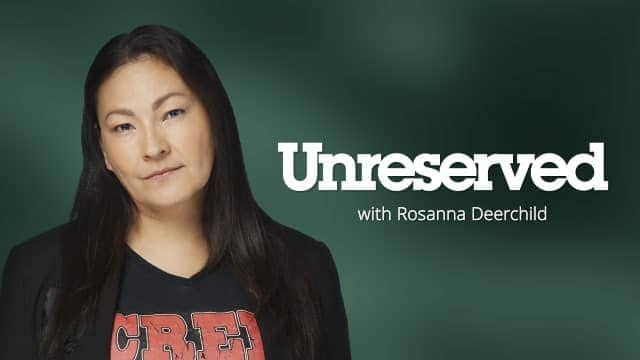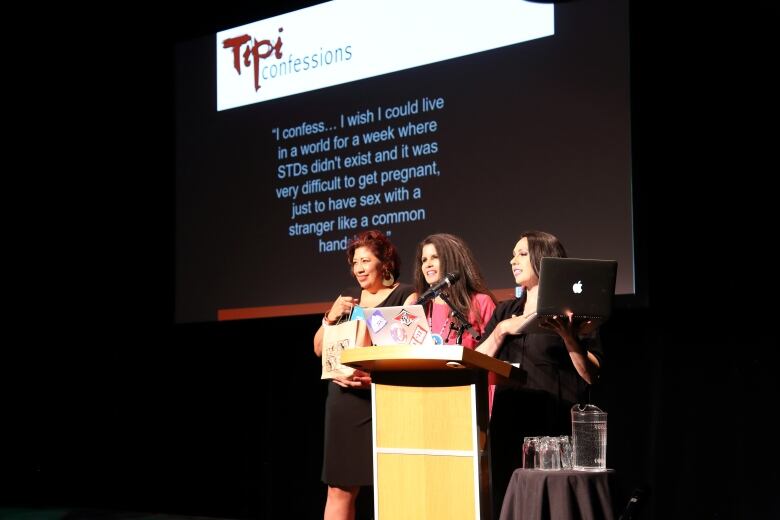Indigenous creators across several artistic disciplines are rediscovering and reclaiming their sexuality through their work — sometimes for fun, other times as a direct response to the negative effects of colonialism. often as a direct response to the effects of colonialism.


Unreserved54:00Indigenous erotica
Not everyone would be willing to confess their sexual secrets to a room full of strangers. That's where Kim TallBear and her Indigenous erotica event, Tipi Confessions, comes in.
"I confess: my first lesbian experience was with a white person. Even if she couldn't give any land back, she did give me many orgasms," says TallBear, reading an anonymous confession written and submitted by an audience member at a show during Toronto's 2019 Queer Film Festival.
The crowd hoots, hollers and cheers.
Tipi Confessions is a live theatre event, with its co-creators and hosts reflecting on sexual desire and sex positivity through an Indigenous lens. Alongside sexy storytelling and performances, the night is punctuated by the anonymous audience confessions.
Some confessions are all about the laughs. Others, about being vulnerable.
"I confess, I have often had sex more for others' pleasure than my own. This bothers me," read co-founder Tracy Bear at a 2015 event in Edmonton, eliciting a sympathetic "aww" from the crowd.

TallBear, who is an Indigenous scholar of science, technology and sex at the University of Alberta, created Tipi Confessions in 2015, with Bear and Kirsten Lindquist, as a play on the Texas show Bedpost Confessions.
"I think that it provides people an opportunity to sit there in an audience, of sometimes a few hundred people, and realize that we all have these awkward, difficult, hurtful, challenging and joyful moments that we can bring into a conversation about sexuality," TallBear told Unreserved's Rosanna Deerchild.
And they're not the only ones exploring this. Indigenous creators across several artistic disciplines are rediscovering and reclaiming their sexuality through their work — sometimes for fun, other times as a direct response to the effects of colonialism.
That work could take the form of Kanina Terry's Hide Babes Calendar, featuring pinup photos of Indigenous men and women in sexy outfits made of moose or deer hide — a style she dubs "bushoir."
"Our bodies are sacred. And I think having a beautiful, soft, sacred hide next to them is … for me, it's just such an amazing feeling," said Terry, who is Anishinaabe-kwe from Lac Seul First Nation in Ontario.
Or Edmonton artist Tashina Makokis, who makes earrings resembling vulvas out of moosehide strips, Swarovski crystals — and thematically appropriate beaver hair.
Indigenous erotica in literature
It's a more diverse landscape compared to when author and publisher Kateri Akiwenzie-Damm first started looking for Indigenous erotica more than 20 years ago.
At the time, she was surprised to find almost none. When she asked writers she knew about the topic, most realized it wasn't even on their radar.

"I'd see a light bulb go off over people's heads when I broached the subject. They would ... start to realize, like, 'Why am I not writing about it?'" she said.
"But when I actually started talking to people, you know, it was just welcomed. People really wanted to have those conversations."
The result of those conversations was Without Reservation: Indigenous Erotica, a collection of poetry and prose by Indigenous writers around the world including Canada, the U.S., Australia and Aotearoa (New Zealand).
It's beautiful for us to love each other. It's beautiful for us to love ourselves.- Kateri Akiwenzie-Damm
Akiwenzie-Damm said she sought out a wide diversity of content for the collection, but she wasn't interested in submissions that were mostly about dominance or violence.
"I was really looking for positivity [and] for positive reflections of Indigenous people loving each other," she explained.
TallBear shares that sentiment, saying that one of the influences behind these stories is a need to break free from the legacy of colonialism, including residential schools in Canada — which erased cultural memories of all kinds.
"When we talk about sex and Indigenous people, it shouldn't just be trauma," TallBear said. "It shouldn't just be that it was turned into a weapon of violence by the settler state and all of its horrible institutions. It's also a way to share joy and power among each other and our intimates."
TallBear has researched how European settlers forced their views of gender, marriage and property on Indigenous populations as part of their assimilation efforts.
"For them, the heads of households can only be men. Marriages are supposed to be monogamous and heterosexual, and they're supposed to last forever" — a far cry from some First Nations cultures, she explained, where polyamorous or LGBT relationships were common.

Settlers unfamiliar with these kinds of relationships either described them as "sexually promiscuous" or strange — and didn't attempt to learn or record much else about them.
"We're missing a lot from the archive, because they wrote down what they saw and they weren't ... capable of seeing everything," TallBear said.
Reclaiming old traditions to build new ones
Terry's path to the spicy side of photography began when she reconnected with a family tradition that had been previously lost.
In 2017, she attended a hide tanning workshop in Thunder Bay, Ont. The craft used to be passed down through Terry's family. But the generation that was forced to attend residential schools, including Terry's mother, was never afforded the opportunity to learn that skill — and all the cultural knowledge that goes with it.
That workshop set Terry on the path to becoming a skilled hide tanner herself. A few years later, she hit a moment of inspiration during an outdoor photoshoot while wearing lingerie and hide.
"It's always just been about, you know, being myself and feeling confident about myself and who I am as an Indigenous woman out in the bush," said Terry.
Terry says a friend who photographed her coined the term "bushoir," and she loved it. Soon, the idea gained momentum. She collaborated with friends and fellow artists to make the first Indigenous Hide Babes calendar in 2021, with a second out now for 2022.
"There's some women, there's some men, there's some awesome hot boys in drag," she said of the 2022 edition.

She also has a non-bushoir calendar out this year for those who are looking to celebrate hide art and fashion in a more G-rated, all-ages context.
Terry has received a lot of positive reactions to her calendars. But the most poignant review might be from her eldest aunt, who wrote her a letter reminiscing about how she used to tan hides when she was younger.
Terry hopes her work helps Indigenous people become more comfortable with themselves and learn more about sex positivity.
And Akiwenzie-Damm shares that vision. "We needed to reclaim that in order to be fully who we are and to recognize that it's beautiful for us to love each other," she said. "It's beautiful for us to love ourselves."
Written by Jonathan Ore. Produced by Kim Kaschor, Laura Beaulne Stuebing and Kate Adach.
Make Me
A poem by Janet Marie Rogers
He makes me naked
and takes me under his skin
holds me in his bloodstream
letting me have a taste
He makes me feel
all warm and fuzzy
cuz he knows what I like
I paddle my way to his heart
feel it start to palpitate
knowing he will hate
himself for loving me
He makes me moan a song
not sung
in quite some time
he knows the rhyme
and together
we make harmony
I tap his spine
with a spike and a pail
harvest sweet sap
and save it for later
when I am alone
running low
on his sticky elixir
bath in it
drink it down
this love
we have found
I make him naked
see his secrets
so exposed
straight to the bone
I take him into my lungs
breathe him in
and out
hold him in my throat
make him tickle when I laugh
and when we do the math
two, can't be divided
by anything
when he says love me
I say
make me